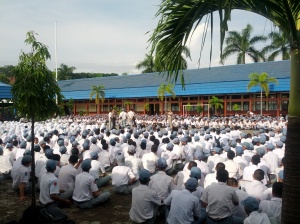“Oh look, Upacara (flag ceremony) on the Thursday.”
That was my first sleep-deprived thought as I groggily stepped off my motorbike to head to my first period class. But I knew something was off. And then it hit me: Upacara is only on Mondays. Passing by hordes of students lining up for the ceremony, I walked towards a flock of teachers who were talking excitedly among themselves. “Bu,” I asked one of teachers, “What’s happening? Why are we having Upacara on Thursday?” This is what she told me:
Yesterday after school, several hundred students from SKN5 (my school), had gone over to SMA2, a rival school, in order to fight students there. Before anything could happen, the police arrived and started to disperse the students, catching some of them and roughing up more than a few. “But why would our students do that?” I asked her, surprised by the aggression of the usually-cheerful students at my school. She chuckled,
“Oh, this go on for a long time. SMK5 and SMA2 fight for many years.”
“But why this time they fight?”
“I think social media, they fight because of that. You understand?”
“No, not really. Who said what on social media?”
“I think SMA2 students write that SMK5 students are poor, come from village, and cause trouble. You know, fighting, lazy, like that.”
I found this whole scenario strange. From what I could make out, SMA2 students had posted messages on anonymous social media site Secret attacking SMK5 students. They had responded by rallying the troops and heading over to SMA2 for a large-scale street fight until the cops showed up. Stranger still was an almost victorious spirit in the air: several teachers even admitted to me that they were secretly proud of our students for standing up for themselves.
Eventually, the headmaster of our school stood up to the podium and addressed the students on the previous day’s occurrence. From what I could tell, it was a message of non-violence, using your head and not your fists to solve problems, etc. Several times during his speech, the students cheered him enthusiastically. They love cheering. Afterwards, a company of police officers were introduced by the headmaster and, after shaking all of us teachers’ hands, gave their own talk about what had transpired. At the end, they asked several students to come up and offer solutions as how the police can better help in these situations (opposed to, you know, roughing them up). To the cheers of their classmates, several older boys instantly sprang up and walked over to the police officer. The advice of one beefy-looking upper-classmen was particularly good: “Tell SMA2 not to post things anonymously on social media about us. BE A MAN and put it on Twitter!”
The whole situation just felt bizarre. When I asked students and teachers what had first started the feud between the schools, mostly I got shrugged shoulders. It was so long ago, no one really knew or even really cared. One teacher proposed that back in the day, SMK5 didn’t have female students as it is a vocational school and probably they would go to other school to date girls, causing problems. That seemed reasonable. But why school-wide street fighting? Was it unique to these schools or was it fairly common?
After a very brief investigation, I found the answer. Not only were school-to-school fights common throughout Indonesia, it was something of a coming-of-age ritual for junior and senior high students. There was even a term for it: Tawuran. Even though it was more common (and far more violent) in urban areas such as Jakarta, tawuran has occurred all throughout Indonesia, causing 82 deaths in 2011. Why was it so widespread? The best answer I could find was this: it’s very, very complicated. There are environmental, cultural, sociological, socioeconomic factors at play. But probably the most significant factor is sense of loyalty and collective responsibility Indonesian students strongly feel towards their school community.
This made sense to me. Concerning my school, it is a vocational institution, which means students learn a trade while studying and usually go straight into the workforce after graduation. It also means that generally, they come from a lower socioeconomic status and are perceived as less intelligent, less successful as non-vocational school students. Which, I must say, is totally false- some of my students are brilliant. But I may be a little biased.. SMA2, on the other hand, is a regular public school which, although not considered the top school in Banjarmasin, is fairly successful academically, and students tend to come from middle/upper-middleclass families. Add a past feud to the cocktail (regardless of whether anyone remembers what it’s about) and there you have it: a violent student cause worth fighting for.
Later in the day, I ran into one of my students who had missed English Club, which had taken place during the time of the Event. “Hey there ___, where were you on Wednesday? You were at SMA2, weren’t you?” I asked him.
“No Mr. Chris, sorry I could not make it. I sick.”
“_____, you can tell me the truth. You were there, weren’t you?”
(Smiling broadly) “Yes Mr. Chris, I there. Sorry I not come to English Club.”
“It’s okay. You know fighting isn’t the way to solve problems, right?”
(Still smiling) “Yes, I know. Thank you.”
“Um….Ok. See you next week.”
I would’ve made an awful school counselor.
